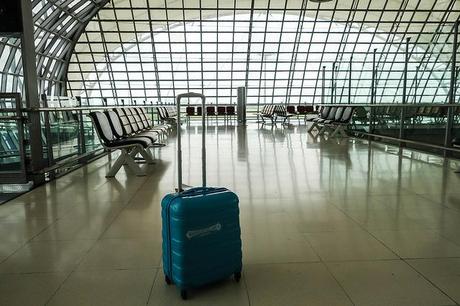A lot of airlines now charge extra for baggage, and thus, many price-savvy passengers do not pay to check their bags, opting to bring one hand-carried piece. But the truth is, the usual 7kg or 10kg limit is not much, and these carry-ons are subject to much scrutiny at the airport. To save money and frustration, here are tips on hand-carried baggage. Read more…

1. Check measurements. Before planning what bag to bring, be sure that its dimensions fit within the guidelines set by the airline—these rules are not universal. Most of the time, airlines are not strict on dimensions, but they do sometimes count and weigh hand-carried baggage—especially when they look big and heavy. Your mileage may vary, but to be safe, just follow their rules. Here are the specifics for airlines in the Philippines:
AirAsia Zest/Philippines (Z2/PQ) one cabin baggage up to 7kg and/or one laptop bag or handbag; both pieces must not exceed dimensions of 56cm X 36cm X 23cm
Cebu Pacific Air (5J) one piece that must not exceed dimensions of 56cm x 36cm x 23cm for Airbus flights and 56cm x 35cm x 20cm for ATR flights; maximum weight is 7kg except for Caticlan (MPH) at 5kg
Philippine Airlines (PR) one carry-on baggage small enough to be placed in the overhead bin or under the seat of the aircraft cabin; maximum dimensions of 45in (length + width + height); maximum weight of 7kg
SEAIR (XO) one piece not more than 5kg plus one laptop
Skyjet (5M) one piece not more than 5kg
Tigerair Philippines (DG) INTERNATIONAL: one piece of baggage plus handbag or laptop; maximum dimensions of 54cm x 38cm x 23cm; maximum weight of 10kg; must fit under the seat or in the storage compartment
DOMESTIC: two pieces of baggage; maximum dimensions of 54cm x 38cm x 23cm; no individual bag must exceed 7 kg; combined weight of two pieces must be maximum of 10kg; must fit under the seat or in the storage compartment
2. Pick a lightweight bag. Provided that passengers are only usually allowed 7kg, then choose a bag that won’t eat through much that small allowance. The good thing nowadays is that there are a lot of cool travel bags which fit usual airline dimensions and weigh less as well—thanks to airlines in the US that charge exorbitant baggage fees.
3. Plan and list stuff to bring. A bulk of my baggage is clothing, and I used to pack too much for a trip. Now, I take time to plan and list what to wear, only packing a few extra garments. This rule doesn’t only apply to clothes but pretty much everything in the bag.
4. Do the ‘roll method’ for clothes. At first, I wasn’t a believer of the ‘roll method’ of packing clothes given the laws of matter. Yet doing it for my last big trip, I was able to economize space and fit 20 days worth of clothes plus extras into just one carry-on.
5. Use sachets and travel-sized items. The density of pure water is a gram per milliliter, and it’s probably more or less the same for our liquid toiletries. That being said, a 100mL bottle of shampoo is 100g plus the weight of the container. Why bring a big bottle of shampoo for a weekend trip when we in the Philippines have sachets for almost everything?
6. Place things in pouches. Often, airport security finds ‘questionable’ things in our carry-on. Quite understandably, they need to verify whether that nail clipper or umbrella is not some security risk item. Storing things in packing pouches, you could easily find that small item in your bag rather than rummaging through your underwear. And you don’t want to be that guy or girl who holds up the x-ray line and annoys rushing passengers, right?
7. Electronics, shoes, and jackets are heavy. A pair of shoes or a jacket can easily weigh half a kilogram or more, while a laptop usually weighs two kilograms. Do you really need a laptop for a weekend trip when you already are bringing a tablet? Can’t you wear your heavy boots and jacket to your flight instead of packing them?
8. Consider buying stuff at your destination. Going on a shopping trip to Hong Kong? Consider wearing some of your purchases for your trip. And don’t worry about not having essentials like toothpaste at your destination—the world is getting invaded by 7-Eleven’s, and unless you’re going to the jungle, the chance of you not finding a store is close to none.
9. Take the rules on hand-carried baggage seriously. Rules on liquids, aerosols, and gels (LAGs) and hazardous materials are absolute laws of air travel, and there’s no way to get around them. Remember, liquids in a carry-on must only be a maximum of 100mL, as must be the container per this online primer. Also, check custom regulations of your destination—you may have harmlessly brought a banana to eat, but you might get into trouble for it.
10. Strongly consider paying for baggage beforehand to avoid penalties. Be realistic—one piece of hand-carried baggage would be appropriate for a trip four or five days, tops. If you’re packing in more stuff or another big bag, you must definitely buy prepaid baggage and save yourself cash (and frustration) at the airport. See, airlines earn a lot from excess baggage fees, so while they encourage you to pre-book your baggage, they won’t be hesitant at all to tack a heavy cost on that bag you thought you can bring onboard. Make sure to check and amend your booking online or through a reservations hotline.
RELATED ARTICLE: What to Bring When Traveling Abroad

